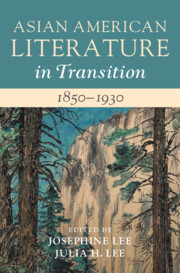Book contents
- Asian American Literature in Transition, 1850–1930
- Asian American Literature in Transition
- Asian American Literature in Transition, 1850–1930
- Copyright page
- Contents
- Illustrations
- Notes on Contributors
- Series Preface
- Introduction: Asian American Literature in Transition, 1850–1930
- Part I Empire and Resistance
- Part II Bodies at Work and Play
- Chapter 7 Objects of an Orientalist Gaze
- Chapter 8 Labor, Freedom, and Typicality in Chinese Canadian Railroad Fiction
- Chapter 9 Bret Harte’s “Heathen Chinee” in US Literature after Slavery
- Chapter 10 On the Genealogy of Asian American Drama
- Chapter 11 Decorative Orientalism
- Part III Crossings
- Bibliography
- Index
Chapter 9 - Bret Harte’s “Heathen Chinee” in US Literature after Slavery
from Part II - Bodies at Work and Play
Published online by Cambridge University Press: 27 May 2021
- Asian American Literature in Transition, 1850–1930
- Asian American Literature in Transition
- Asian American Literature in Transition, 1850–1930
- Copyright page
- Contents
- Illustrations
- Notes on Contributors
- Series Preface
- Introduction: Asian American Literature in Transition, 1850–1930
- Part I Empire and Resistance
- Part II Bodies at Work and Play
- Chapter 7 Objects of an Orientalist Gaze
- Chapter 8 Labor, Freedom, and Typicality in Chinese Canadian Railroad Fiction
- Chapter 9 Bret Harte’s “Heathen Chinee” in US Literature after Slavery
- Chapter 10 On the Genealogy of Asian American Drama
- Chapter 11 Decorative Orientalism
- Part III Crossings
- Bibliography
- Index
Summary
This chapter argues that anti-blackness lived on in the afterlife of slavery in Bret Harte's writings about the American West featuring the Chinese worker during Reconstruction. Through the evocation of minstrel figures in literature such as Topsy from Uncle Tom's Cabin, Harte's fictional writings reveal the ways in which anti-blackness functions as cultural form, rooted in slavery and the representational practice of blackface minstrelsy. In particular, the character of Topsy lived on through his Chinese worker characters in the West, beginning with and exploited further after the phenomenal success of his poem "Plain Language from Truthful James." In addition to reading the poem in the context of Reconstruction debates on changing definitions of enslaved/"heathen" and free labor, I propose noting the residual representational practices of blackface minstrelsy that pervaded much of nineteenth-century US literature as formal attributes of Harte's poem. Doing so reveals that Harte's West and the Chinese worker were not separate from Reconstruction and the history of slavery, colonialism, and racial violence in the United States in the construction of "American humor."
Keywords
- Type
- Chapter
- Information
- Asian American Literature in Transition, 1850–1930 , pp. 156 - 170Publisher: Cambridge University PressPrint publication year: 2021



